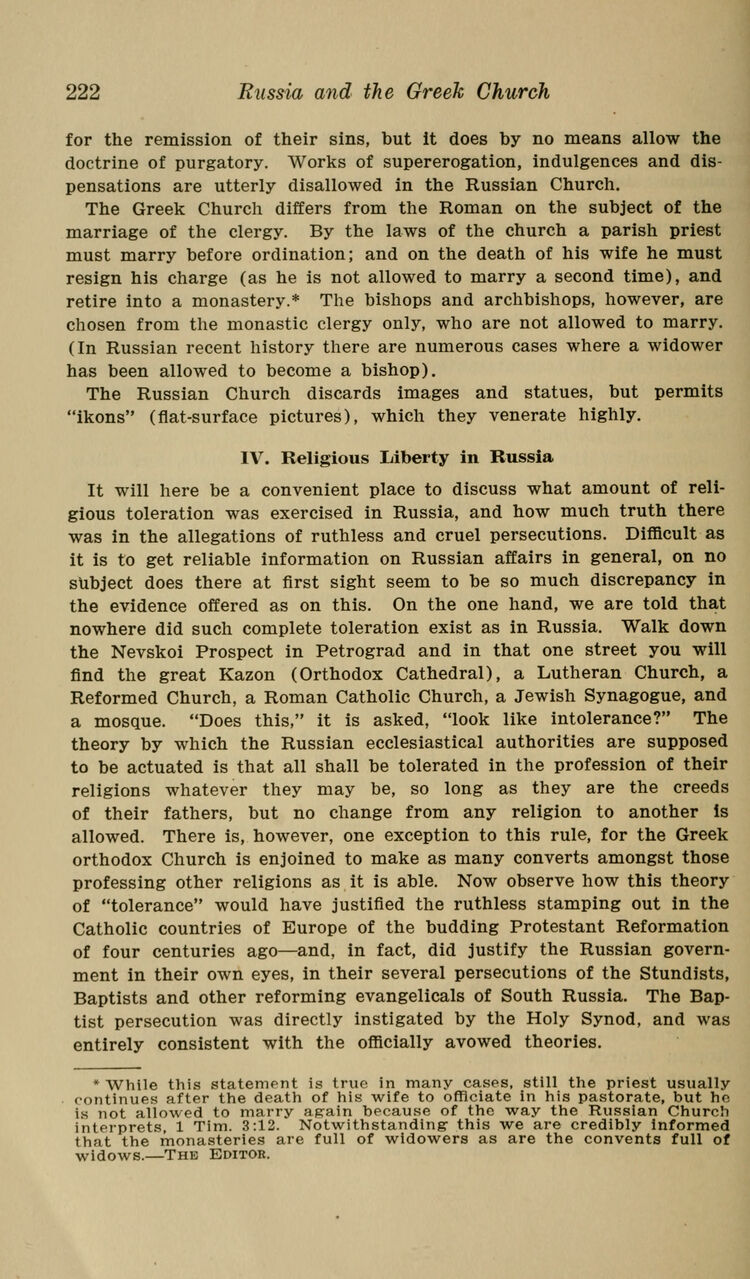
Full resolution (JPEG) - On this page / på denna sida - Russia and the Greek Church. The Rev. Elias Newman - Poings of Contrast - IV. Religious Liberty in Russia

<< prev. page << föreg. sida << >> nästa sida >> next page >>
Below is the raw OCR text
from the above scanned image.
Do you see an error? Proofread the page now!
Här nedan syns maskintolkade texten från faksimilbilden ovan.
Ser du något fel? Korrekturläs sidan nu!
This page has never been proofread. / Denna sida har aldrig korrekturlästs.
222 Russia and the Greek Church
for the remission of their sins, but it does by no means allow the
doctrine of purgatory. Works of supererogation, indulgences and dis-
pensations are utterly disallowed in the Russian Church.
The Greek Church differs from the Roman on the subject of the
marriage of the clergy. By the laws of the church a parish priest
must marry before ordination; and on the death of his wife he must
resign his charge (as he is not allowed to marry a second time), and
retire into a monastery.* The bishops and archbishops, however, are
chosen from the monastic clergy only, who are not allowed to marry.
(In Russian recent history there are numerous cases where a widower
has been allowed to become a bishop).
The Russian Church discards images and statues, but permits
"ikons" (flat-surface pictures), which they venerate highly.
IV. Religious Liberty in Russia
It will here be a convenient place to discuss what amount of reli-
gious toleration was exercised in Russia, and how much truth there
was in the allegations of ruthless and cruel persecutions. Difficult as
it is to get reliable information on Russian affairs in general, on no
subject does there at first sight seem to be so much discrepancy in
the evidence offered as on this. On the one hand, we are told that
nowhere did such complete toleration exist as in Russia. Walk down
the Nevskoi Prospect in Petrograd and in that one street you will
find the great Kazon (Orthodox Cathedral), a Lutheran Church, a
Reformed Church, a Roman Catholic Church, a Jewish Synagogue, and
a mosque. "Does this," it is asked, "look like intolerance?" The
theory by which the Russian ecclesiastical authorities are supposed
to be actuated is that all shall be tolerated in the profession of their
religions whatever they may be, so long as they are the creeds
of their fathers, but no change from any religion to another is
allowed. There is, however, one exception to this rule, for the Greek
orthodox Church is enjoined to make as many converts amongst those
professing other religions as it is able. Now observe how this theory
of "tolerance" would have justified the ruthless stamping out in the
Catholic countries of Europe of the budding Protestant Reformation
of four centuries ago—and, in fact, did justify the Russian govern-
ment in their own eyes, in their several persecutions of the Stundists,
Baptists and other reforming evangelicals of South Russia. The Bap-
tist persecution was directly instigated by the Holy Synod, and was
entirely consistent with the oflacially avowed theories.
* While this statement is true in many cases, still the priest usually
continues after the death of his wife to officiate in his pastorate, but he
is not allowed to marry aprain because of the way the Russian Church
interprets, 1 Tim. 3:12. Notwithstanding- this we are credibly informed
that the monasteries are full of widowers as are the convents full of
widows.
—
The Editor.
<< prev. page << föreg. sida << >> nästa sida >> next page >>